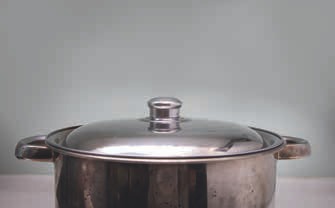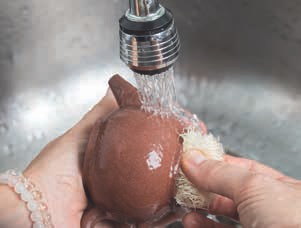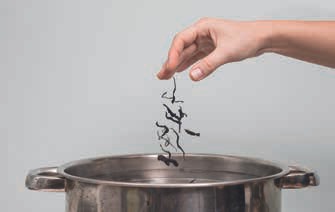Materials You Need

- A stainless steel cooking pot and lid, ideally not used to cook food and large enough to contain your teapot.
- Pure white ash, purchased or sifted from your brazier is ideal. Alternatives: In Taiwan, they sell a lemon-based powder for cleaning teaware, which is second best after charcoal ash, but maybe not available in the West. Sodium percarbonate, non-chlorine oxygen bleach in lieu of pure white ash is okay. In fact, we always use this for an especially dirty, old pot. It is water soluble, meaning it will be completely gone after a few boilings, which we'll get to in the procedure (just don't use regular bleach, containing sodium hypochlorite).
- A heat source (gas, electric or infrared stove).
- Spring water. (You can use tap water, but good spring water is much better!)
- Optional: "medicine stones (mai fan shi, 麥飯石)," bamboo or white charcoal and/or crystals. (All the things you use in your water urn that you use to store water for tea.)

There's not a lot of information on how to scour your Yixing teapots in
English, and it is one of the most asked questions around here, so we
thought this issue was the perfect opportunity to share our method. This
method could be applied to teaware for bowl tea, but it's ideal for gongfu
tea.
Whether you have a new or used Yixing teapot, or one of unknown origin,
it's often a good idea to scour it before using it. If the pot is heavily
used, you
may have to repeat the following process several times. This will remove
the oils
of any tea prepared in the pot, which may not have been organic or fine
tea, and
will negatively influence your own sessions. Scouring is necessary, as we
want to
thoroughly clean out anything that would influence the tea steeped in the
pot,
like organic matter, mustiness, dust or tea oils from other steepings
caught up in
the pores of the teapot.
When a new pot is fired, all the organics in the clay become dust. Potters
also
use silica in the firing process to keep the lid from adhering to the body.
All of this
dust and sediment clogs the pores of the Yixing pot. The double-porous
structure
of an Yixing pot is what allows for capillary action: the pot breathes, in
a way of
speaking. This is one of the reasons that Yixingware preserves heat so
well. Also,
we want the pores open to absorb the oils of the tea we will prepare,
seasoning
the pot over time. It will then improve our tea and begin to glow with a
brighter,
more beautiful shine over time, much like the way our prayers polish our
malas.
Scouring your pot is also a necessary treatment for a teapot that you plan
to
use for multiple types of tea. This will be the case for many of you, if
you only
have one or two teapots, which you use for different teas. In the
beginning, if you
only have one gongfu teapot, then use it for all your teas and simply scour
it every
six months to a year, depending on how much you use it. This is because
your
pot will accumulate oils from the various teas you brew in it, which will
influence
all of your tea sessions, noticeably as time passes. It's nice to enjoy tea
in its purest form, not influenced by other teas. You can "reset" your pot,
in a manner of
speaking, by scouring it. However, it is always ideal to collect enough
teapots to
assign them to all the types of tea you enjoy.
We'd also love to hear about your successful scourings! Let us know your
experience on the app.

Procedure
Make sure your cooking pot and lid are clean and washed completely of any
soap. You never want to wash
your teaware with soap. (We devote a pot just to scouring pots, so it never
touches food, dish soap or any
other contaminants. This is, of course, the ideal for the serious Chajin.)
- Add some water to your cooking pot and carefully place your gongfu teapot inside. Remove the teapot lid and place it next to the body. Everything should be fully submerged in water. If spring water is hard to come by, it's okay to use tap water in this first stage, because you're going to use ash in the next step and it will all be boiled away in subsequent steps. Nevertheless, spring water throughout the process is ideal. This can be done with multiple teapots, depending on the size of your cooking pot. However, arrange them so they won't bump into each other too much. (You can add crystals, medicine stones and charcoal to the pot, making sure to place them properly so they won't rattle up against your pot.)

- Bring the water to a boil over your heat source. We use a gas stove.
- As the water comes to a boil, have your cleaning agent ready. You will only need a teaspoon of the ash or a half teaspoon of the bleach powder. Once the water has come to a full boil, carefully scatter the cleaning agent around the surface of the boiling water. At this point, immediately turn off the heat. This is particulary important if you use bleach, because it will bubble and overflow if you keep the heat on!

- Put a lid on the cooking pot and let it sit overnight (around 8-12 hours). Make sure it's labeled and in a safe spot, so others don't move it or bump it accidentally!

- The next morning, discard the water and thoroughly clean the cooking pot with warm water.
- Clean your teapot and lid carefully under cool, running water. Here, you can use a very soft and natural cloth or a cleaning pad (make sure it has no chemicals in it, as many brands fill these with cleaning agents). We use a dried piece of loofah, which we have found to be ideal and all natural. Clean the entire surface of the teapot. You can also just use your thumb and fingers if you are scouring a new pot that doesn't require as deep or thorough of a scour. Whatever you do, do not use soap!

- Once everything is clean, place the teapot and lid back in the cooking pot. Refill it with clean water and bring it to a boil again. Ideally, this should be better water than before, like the spring water you would use to make tea. Do not add any more cleaning agent (ash or oxygen bleach). Once it has come to a full boil again, turn off the heat, put the lid on the cooking pot and let it cool down for about four hours. Discard the water and repeat the cleaning process (clean the cooking pot with warm water, and the teapot using your thumbs, a cloth, scouring pad or loofah).

- Repeat steps six and seven until your teapot is clean. It will probably take two to four cycles depending on how used the pot was. Just keep boiling it in spring water, rinsing/scouring under the faucet, boiling, scouring, boiling... The aim is to remove all the residue from the pores, as well as all the cleaning agent itself. There are a few things to look for to know when your teapot is clean:

- Look at the surface of the water in the cooking pot after the water has cooled down. If there is any residue on top, you need to keep cleaning.
- Smell the teapot after each cleaning. There should be no smell. Both bleach and ash have a signature smell.
- If you're using oxygen bleach, you can also use your hands because the bleach is slippery to the touch.
- As a final measure, maybe after a few boilings, you can add some clean water into your teapot, pour it out into a clean cup and taste a small amount. You'll know by tasting it if there is anything unwanted inside.
- After that, your teapot is ready to brew tea!
- Make sure not to let your teapot sit in the water for too long at any stage. This process will take a couple of days, but if you neglect the recommended guidelines, you may need to start over entirely from the beginning!
- If you are going to use your teapot for more than one type of tea, always remove the spent tea leaves and liquor from your pot immediately after use! Clean it thoroughly under running water, and leave it out in a safe spot to air-dry with the lid removed. Once dry, store it away.
- If you are going to season your teapot with a specific type of tea, you can proceed with the following, tenth step. (This step is unnecessary if you are going to use your teapot for more than one type of tea.)


- Place your teapot and lid back into the clean cooking pot and add water. Bring the water to a boil and add a few leaves (2 - 3 grams) of the tea you wish to brew in your teapot, turn off the heat and let it steep for a few hours. Discard the tea liquor, and rinse your teapot and lid under running water with your thumbs. (Remember, you only want to do this if you are sure about using only one kind of tea with this teapot.) Before using the teapot, you can rinse it two or three more times with water from the kettle at the tea table itself. You may also want to try it a couple of times before using it to serve tea to guests.












